

Updated chassis geometry features slightly steeper rake (0.5 degree) and 3mm less. The result is more weight on the front wheel.
It’s hard to imagine that nearly three decades have passed since the first Kawasaki Ninja sportbike was unleashed on the motorcycling public (1983 GPZ900R). That motorcycle helped usher in the generation of sportbikes we enjoy today. Now Team Green is at it again, evolving the technical aspects of high-performance motorcycles with the release of its 2011 Kawasaki Ninja ZX-10R. With the introduction of this Superbike, Kawi engineers have integrated a number of technologies that make it easier to ride than ever before. For the full technical briefing make sure to check out our 2011 Kawasaki Ninja ZX-10R First Look article. In this review we’ll focus on our riding impression and how it performs at the racetrack.
ELECTRONICSNever in a million years did I think there would come a day that I’d say this, but, without question the most exciting feature of the new ZX-10R has nothing to do with the engine, chassis or anything else mechanical. It all comes down to a tiny black box and two sensors attached to each wheel. These are the primary components that make up the Sport-Kawasaki Traction Control (S-KTRC).
Motorcycle USA takes to the track with Kawasaki's fully redesigned Ninja ZX10R in our 2011 Kawasaki Ninja ZX-10R First Ride Video.
The system is the most advanced traction control system we’ve ever used on a production motorcycle. It is designed to allow riders to get closer to the “limit” of the motorcycle’s performance by optimizing rear wheel spin and engine acceleration. Part of the reason the system works so well is because it is adaptive to riding conditions. Unlike other systems there are no pre-determined engine fuel or ignition maps. The system is constantly making calculations based on throttle position, engine acceleration, gear position (load force) and front and rear wheel speeds. This allows it to “predict” what might happen and adjust the engine’s ignition curve in real-time.
Four different modes are available based on rider preference or road conditions. Level 1 is designed for track use with racing tires. Level 2 is for general sport riding on either the street or racetrack, while Level 3 is for use in the wet or on slippery road surfaces. The system can also be disabled completely.
Each mode is selected by holding down a toggle button on the left clip-on for approximately one second. This can be done on the fly as long as the throttle is closed. The selected mode is then displayed on the LCD cockpit display. Furthermore the chosen mode selection is stored when the bike is turned off and on again.
Considering we’d never turned a wheel at Georgia’s Road Atlanta not to mention the chilly asphalt temperature, we began the test by riding the bike in Level 2 mode. With its sheer number of blind turns and rises Road Atlanta is a very tricky circuit to learn. Still within just a handful of laps it became immediately clear the benefits of the S-KTRC.
There are a number of dips and rises on the track where the bike will power wheelie in second, third and even fourth gear. The TC incorporates a wheelie control functionality that allows you to literally keep the throttle pinned as the front wheel lifts off the ground during a power wheelie. To my surprise, it actually took considerable seat time to get used to this feature as my brain is hard-wired to either: lift off the throttle, dab the rear brake, or tap the clutch lever to get the front wheel back on the pavement. But if you can turn-off your brain and put 100% faith in the electronics it’s simply incredible how well it works with it completely mitigating the chance of the bike looping out and instead putting the front wheel down in a smooth and very natural feeling manner. However, we did notice the system felt herky-jerky in Level 3 as the bike would wheelie then set down and repeat.
After I had put certain segments of the track together I started to get greedy with the throttle when standing the bike up off corners. The rear tire would still spin slightly but it would do so in such a way that you could feel the bike trying to maximize every bit of forward drive. It felt like it would spin, grip, spin, grip as opposed to just spinning excessively when we attempted the same maneuvers with S-KTRC disabled.
But the craziest thing is just how unobtrusive the system is, especially in Level 1. It works its magic so inconspicuously that it’s difficult to tell that it’s even working (there is a segmented bar graph-style TC activation meter on the dash that displays how active it is working but you need to take your eyes off the road to view it). As opposed to other TC systems employed on say the BMW and Ducati, the Kawi’s set-up is far less intrusive when activated and it doesn’t feel like it's restricting acceleration as much.
So will the TC system make the bike totally crash-proof? Not exactly. To test, I dialed in heavy throttle while transitioning from the edge to shoulder portion of the rear Bridgestone BT-003 race tire (learn more about this tire in the Bridgestone Battlax BT003 Tire Comparison) and one time the bike rear end snapped sideways and I popped out of the seat. The only thing that prevented me from crashing was basically luck.
If it doesn’t keep you from crashing what is it good for then? Think of it this way: The TC system takes off the “edge” of aggressive throttle input. It helps smoothen out the load you place on the rear tire during acceleration which in turn reduces wheel spin and maximizes acceleration off a corner. If you’re skilled enough you can certainly accomplish the same goal with your right wrist (Mat Mladin-style) but you’ll never be as consistent as the machine. Hands down this is the best feature of the new 10R and worth every penny of its $13,799 base MSRP.
ENGINE

The new Ninja ZX-10R is a very easy motorcycle to ride around the racetrack.
Although the basic architecture of the engine, including its Inline-Four configuration, firing order and bore and stroke measurements are identical to the previous model year, many of the internal parts have been reworked. For more technical details refer to the 2011 Kawasaki Ninja ZX-10R First Look.
The previous generation Ninja certainly didn’t lack any top end engine performance with it pumping out in excess of 160 horsepower at the rear tire (see the 2010 Kawasaki ZX-10R Comparison Track article). Although Kawasaki claims maximum power output to have increased it felt comparable to the 2008-2010 Ninja. Kawasaki did note that in stock form the U.S. spec ZX-10Rs are fairly restricted. To prove this they had a “Power Up” bike with a racing exhaust and different ECU and it did feel considerably faster and comparable to BMW’s S1000RR rocket ship. What did feel different however is the way in which the engine generates thrust.
The top-end power hit of yesteryear is gone and the powerband feels flatter than before (good thing). Throttle response continues to be excellent and the engine is very usable and friendly to manipulate at all rpm. We did notice however that it doesn’t pull with the same voracity as you close in on redline with power flattening up slightly. But we did appreciate the soft manner in which the engine hits the rev limiter which felt almost identical to the Z1000 (see the 2010 Kawasaki Z1000 First Ride). The exhaust note continues to be very quiet but there is still a fair amount of air intake howl, much to our pleasure.
The 10R now incorporates an engine power mode selection system similar to Suzuki’s GSX-R line of sportbikes. Three power modes are available ranging from “F” (full power mode), “M” (variable middle power—allows 75% of max power with a less aggressive power curve. Furthermore full power can still be accessed based on the throttle angle rate of change) and “L” (low power—60% of maximum with an even milder power curve). Similar to the S-KTRC system the power mode can be adjusted on the fly (as long as the throttle is closed) by pressing up on the left-hand clip-on toggle button for approximately one second. The selected mode is then displayed right above the S-KTRC setting on the instrument panel with the setting being retained when the bike is restarted.
CHASSISOne of the biggest complaints we had with the old bike was how top-heavy it felt. The new Ninja has shed 22 pounds of mass with it now weighing in at 437 pounds with a full 4.5-gallon fuel load. Even better though is how much better its center of gravity feels.
Without riding the bikes back-to-back it was difficult to discern if the new Ninja steers any easier than the old one. Still we wouldn’t exactly term it as “flickable” but it did seem to steer more predictably than before which felt like it could be attributed to its improved mass centralization more than anything. We did notice how much more stable the bike is at high speeds with it headshaking far less than we’ve experience in the past.
We were generally pleased with the performance of last year’s fork and the new Showa BPF continues to provide excellent performance. It does a terrific job of controlling chassis pitch during hard braking, which we experienced entering Road Atlanta’s Turn 10 where you slow down from an indicated speed of 186 mph down to second gear.
Speaking of braking the Ninja continues to offer a very powerful braking set-up. Outright stopping force is incredible and the brakes didn’t fade at all at our pace. Initial bite is rather low which helps make the brakes easier to use for a novice rider but gradually ramps up as lever force is increased. Additionally the Ninja now offers an anti-lock braking system available as a $1000 option. The system only adds six pounds to the weight of the motorcycle; however it cannot be disabled like say the system employed on the BMW S1000RR. The bikes we rode were not outfitted with the system so look for a review in the future.
Even more impressive than the fork perhaps was the new horizontally-mounted Showa shock absorber. Overall the rear end of the bike seemed to squat less during hard acceleration and there was a high-level of feel during cornering. When you combine that along with the fantastic grip from the Bridgestone BT-003 race tire and phenomenal performance of the traction control system, the package facilitates strong drives off corners. Damping force also remained consistent throughout our 20-minute riding sessions.
ERGONOMICSNext to the performance of the traction control system the revised cockpit and riding ergonomics is another area where the new 10R shines. Part of the reason why it feels much less top heavy than before is the 0.7 inch reduction in seat height. The profile of the fuel tank is also vastly improved with it feeling much more compact than before. We also liked

The traction control system employed on the new 10R is the best system we’ve ever tested on a production motorcycle.
the way it was shaped which allowed us to grip it better during hard braking. The clip-ons also seemed to have a more logical bend that should prove to be more accommodating on the street as well. The position of the footpegs is now adjustable, which is another big plus for both street and track riders. Generally the cockpit was well proportioned and wasn’t at all cramped for my above average six-foot-tall frame.
FINAL THOUGHTSAlthough we weren’t blown away by the added performance of the engine or chassis as compared to last year’s bike the electronics package on the new 10R is out of this world. Not only does it make the bike easier and safer to ride it allows you to better explore the astronomically high-performance that a modern day Superbike serves up. And to think that you can get a taste of a similar type of traction control and engine management technology that MotoGP bikes were using just a few years ago for a list price of $13,799 is absolutely mind boggling. Kudos to Kawasaki for continuing to evolve the realm of sportbikes with its easy-to-use and gimmick-free traction control system.
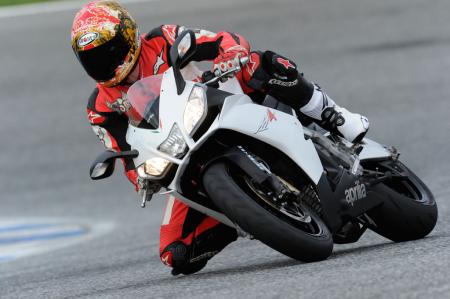 Is the base model RSV4 any good? Oh yeah!
Is the base model RSV4 any good? Oh yeah! 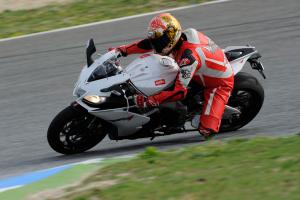 Despite a lesser-spec suspension and a few extra pounds, the RSV4 R is still an extremely impressive handler.
Despite a lesser-spec suspension and a few extra pounds, the RSV4 R is still an extremely impressive handler.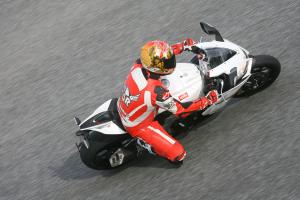 The RSV4's compact dimensions are even palatable for Tor's tall frame.
The RSV4's compact dimensions are even palatable for Tor's tall frame.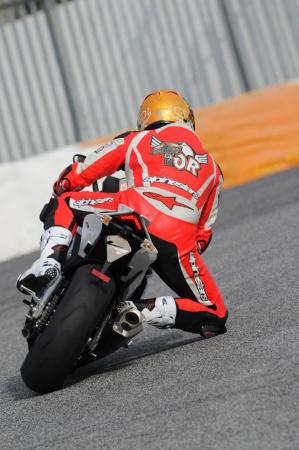 Like WSBK rider Max Biaggi, Tor says he feels at home on the RSV4 R.
Like WSBK rider Max Biaggi, Tor says he feels at home on the RSV4 R.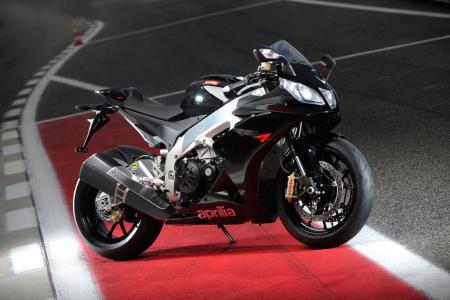 The $5000 difference in price between the RSV4 R and the upscale RSV4 Factory will be worth it to only the most discriminating clientele.
The $5000 difference in price between the RSV4 R and the upscale RSV4 Factory will be worth it to only the most discriminating clientele. 























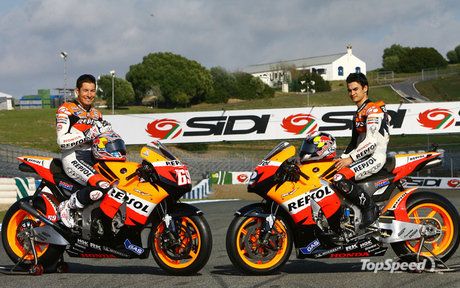
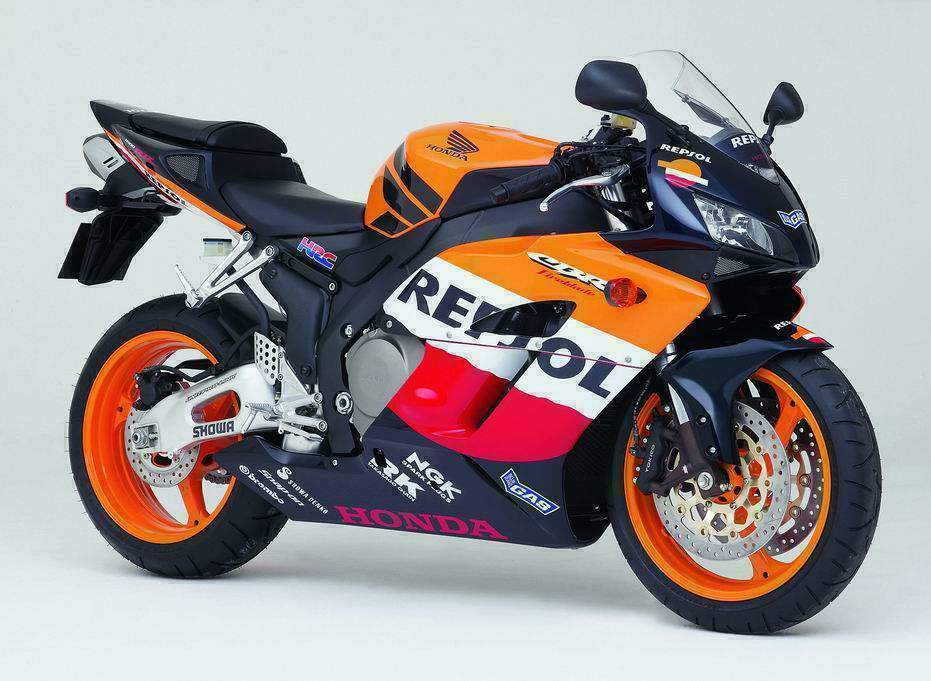




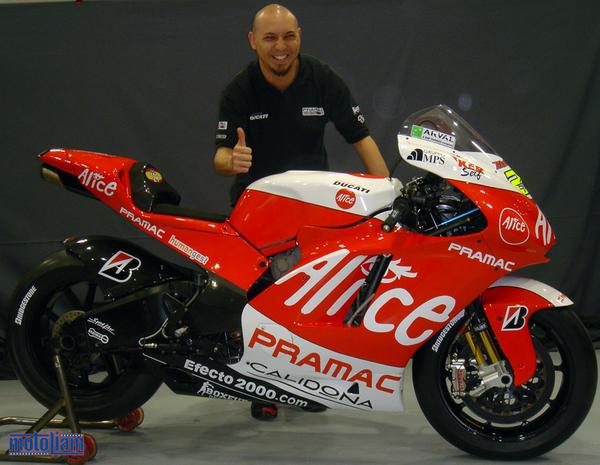






 Then it was time for the big one everybody had been waiting for – the Diavel. After showing several new videos showing the Diavel in action the stage exploded in light and smoke as a female rider rode the Diavel on to the stage. After some banter about the rider having to move off the bike so that we could appreciate the Diavel without any eye candy two more Diavels entered the stage. One white/aluminum colored and one in all black. The Red/black version is called Diavel Carbon and as the name implies it gets lots of carbon fiber bits.
Then it was time for the big one everybody had been waiting for – the Diavel. After showing several new videos showing the Diavel in action the stage exploded in light and smoke as a female rider rode the Diavel on to the stage. After some banter about the rider having to move off the bike so that we could appreciate the Diavel without any eye candy two more Diavels entered the stage. One white/aluminum colored and one in all black. The Red/black version is called Diavel Carbon and as the name implies it gets lots of carbon fiber bits. Ducati revealed that the 1200cc engine is a devil indeed with figures claiming 162hp @ and 128Nm @ 8,000rpm. The Diavel gets DTC and ABS slightly modified from the items on the Multistrada 1200. New is also an extra display on the fuel tank dealing with the rider aids. The LCD panel is made from pretty much the same goodies as modern smart phones.
Ducati revealed that the 1200cc engine is a devil indeed with figures claiming 162hp @ and 128Nm @ 8,000rpm. The Diavel gets DTC and ABS slightly modified from the items on the Multistrada 1200. New is also an extra display on the fuel tank dealing with the rider aids. The LCD panel is made from pretty much the same goodies as modern smart phones. Interestingly Ducati has developed the bike to feature an all new rear tire size with Pirelli. The new Pirelli Diablo Rosso II in 240/45-ZR17 has an extremely low profile that makes the bike look menacing from the back coupled with an equally wide tail section. The front end is dominated by a huge round headlight flanked by what look like air intakes. The seat height is very low at 30.3 in. and the seat is well padded and looks comfy. ABS on Brembo monoblock brakes will be interesting to test. The bike is very long and it looks like the front would be pushed a bit with those powerful brakes and long wheelbase. The fuel tank carries 4.5 gal. of fuel.
Interestingly Ducati has developed the bike to feature an all new rear tire size with Pirelli. The new Pirelli Diablo Rosso II in 240/45-ZR17 has an extremely low profile that makes the bike look menacing from the back coupled with an equally wide tail section. The front end is dominated by a huge round headlight flanked by what look like air intakes. The seat height is very low at 30.3 in. and the seat is well padded and looks comfy. ABS on Brembo monoblock brakes will be interesting to test. The bike is very long and it looks like the front would be pushed a bit with those powerful brakes and long wheelbase. The fuel tank carries 4.5 gal. of fuel. One thing is for certain and that is if you want to run with the devil, or Diavel, you are going to need some hair on your chest. It’s a very macho and un-Italian bike. I asked Domenicale whether the development team had any US input, but he categorically denied this stating it was a 100% Italian effort. There’s also an issue with categorizing this bike as Ducati stands hard on claiming they have created a new segment. Whatever Ducati says, this bike will be compared with uneven competition such as the Harley-Davidson Muscle/V-Rod, Yamaha V-Max, Suzuki B-King, Moto Guzzi Griso 8V and perhaps even Triumph Rocket III Roadster. The way I see it they all belong together in a type of muscle cruiser bruiser streetfighting soup of delightful torque and power. Harley-Davidson could have built a bike such as the Diavel when it developed the V-Rod with Porsche. However, Erik Buell once told me that that’s what he wanted to do, but the corporate Milwaukee muscle opted for something nearer to a traditional H-D product and bulked up as they always do.
One thing is for certain and that is if you want to run with the devil, or Diavel, you are going to need some hair on your chest. It’s a very macho and un-Italian bike. I asked Domenicale whether the development team had any US input, but he categorically denied this stating it was a 100% Italian effort. There’s also an issue with categorizing this bike as Ducati stands hard on claiming they have created a new segment. Whatever Ducati says, this bike will be compared with uneven competition such as the Harley-Davidson Muscle/V-Rod, Yamaha V-Max, Suzuki B-King, Moto Guzzi Griso 8V and perhaps even Triumph Rocket III Roadster. The way I see it they all belong together in a type of muscle cruiser bruiser streetfighting soup of delightful torque and power. Harley-Davidson could have built a bike such as the Diavel when it developed the V-Rod with Porsche. However, Erik Buell once told me that that’s what he wanted to do, but the corporate Milwaukee muscle opted for something nearer to a traditional H-D product and bulked up as they always do. The Diavel weighs in at what for this type of bike is an ultralight claimed 463 pounds. The whole Diavel project is a bit of a gamble for Ducati which it admits to when asked who its customer for this bike is. But we guess Ducati has applied the philosophy of “let’s build it and they’ll come.”
The Diavel weighs in at what for this type of bike is an ultralight claimed 463 pounds. The whole Diavel project is a bit of a gamble for Ducati which it admits to when asked who its customer for this bike is. But we guess Ducati has applied the philosophy of “let’s build it and they’ll come.” I personally need the design to grow a little bit on me. Let’s put it this way, I’m not completely convinced Wolverine would suit the Diavel. It remains to be seen whether the Diavel can achieve the same iconic profile as the V-Rod. A bike like this is bought with the heart through the eyes, not necessarily with what’s best through your right hand on the twisties. Let’s hope it can do well, I love the name!
I personally need the design to grow a little bit on me. Let’s put it this way, I’m not completely convinced Wolverine would suit the Diavel. It remains to be seen whether the Diavel can achieve the same iconic profile as the V-Rod. A bike like this is bought with the heart through the eyes, not necessarily with what’s best through your right hand on the twisties. Let’s hope it can do well, I love the name!













